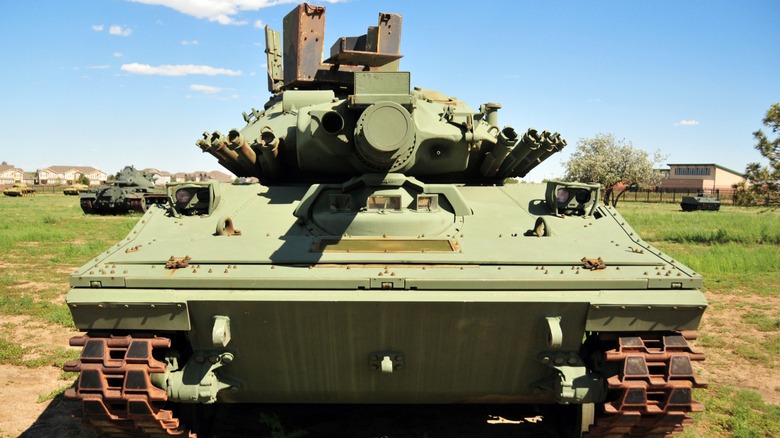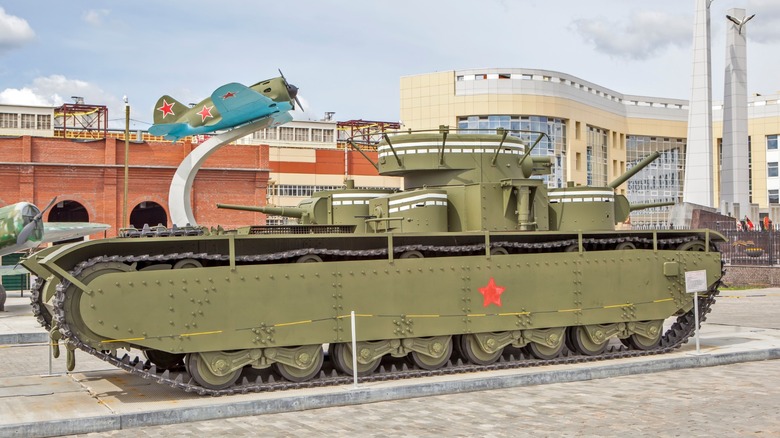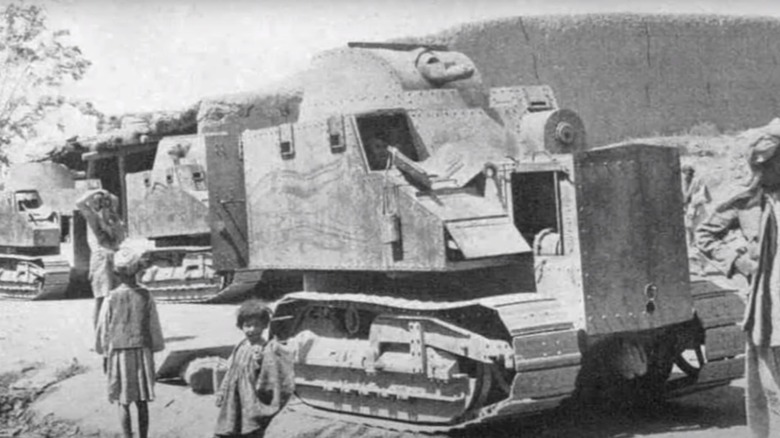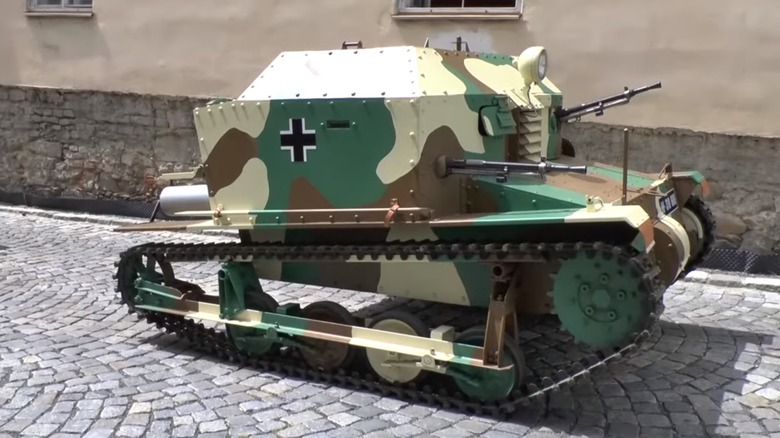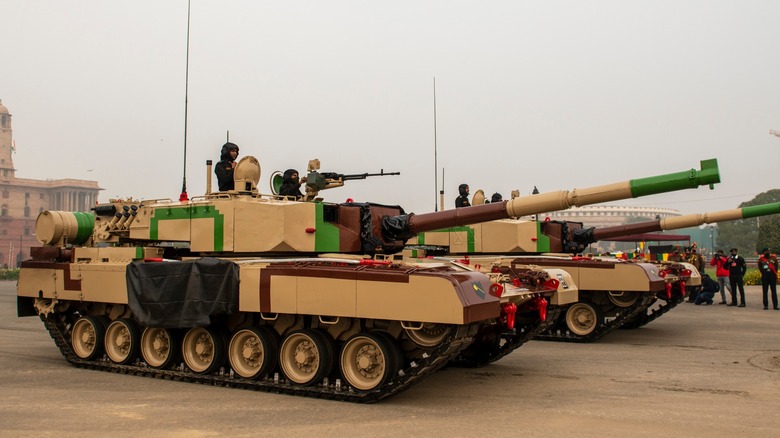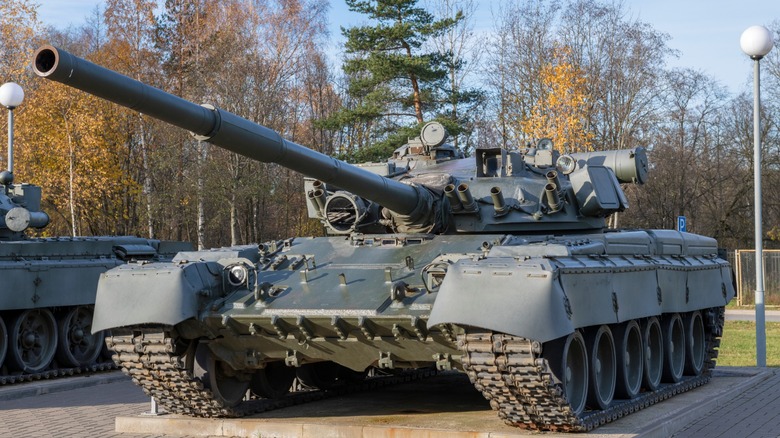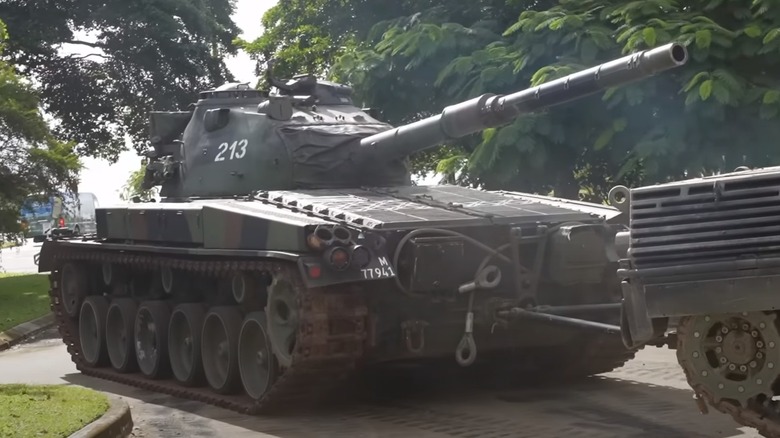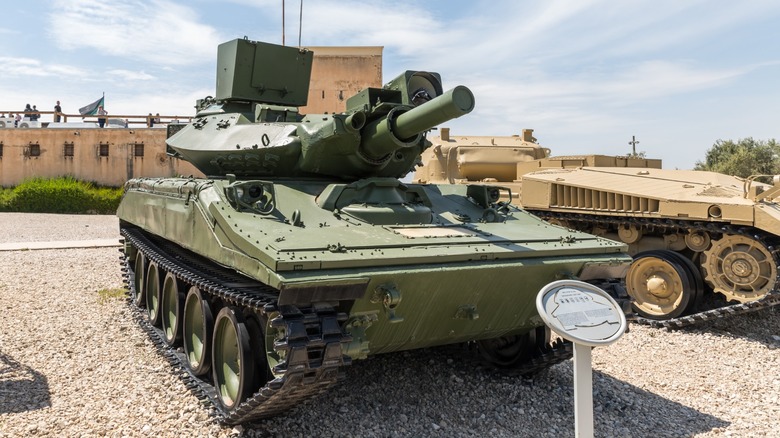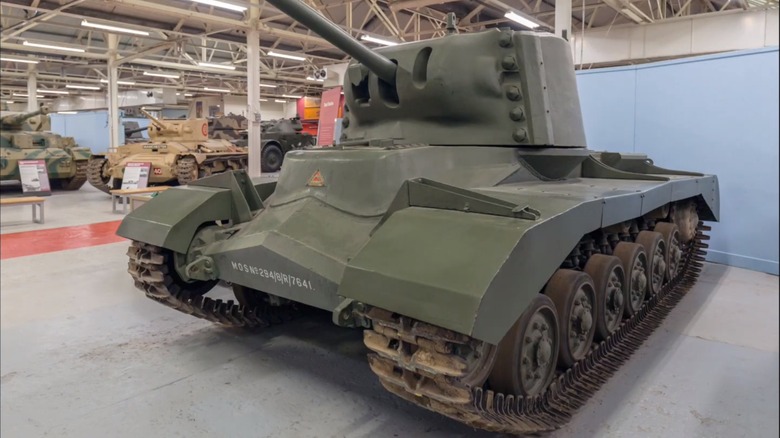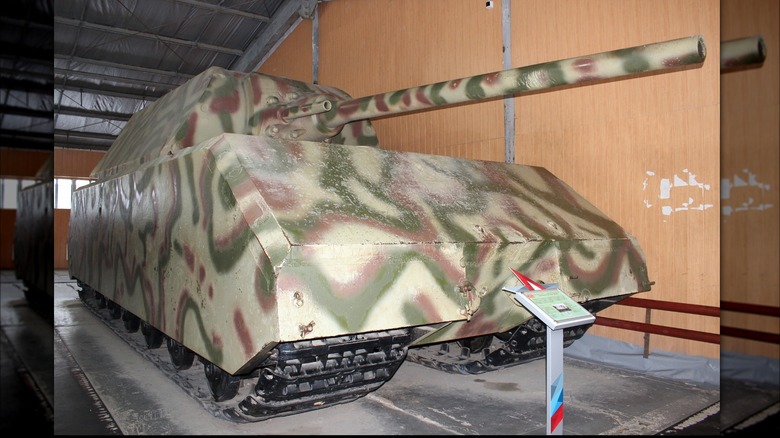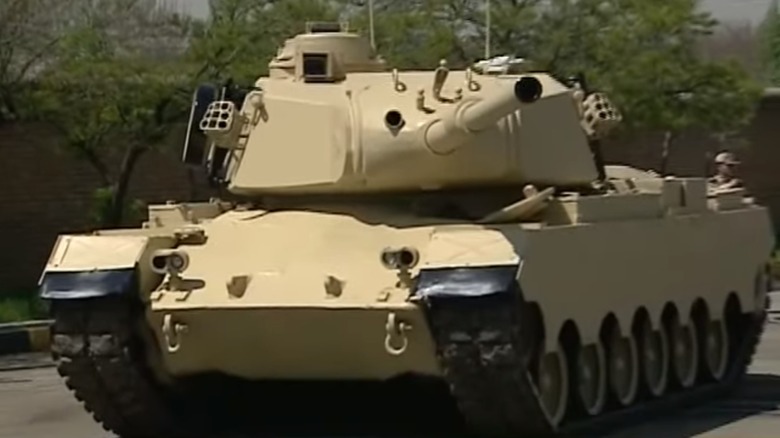10 Of The Worst Military Tanks Ever Built
The introduction of the tank by the British during World War I altered modern mechanized warfare forever. During early battles of the war, troops needed a solution that could traverse the open trenches while protecting its occupants and providing cover fire for ground support following behind. When they had came up with this machine, they were labeled as "water tanks" to disguise their true nature from any spies who might see the shipping manifests of cargo headed towards the front lines. The name stuck and they have simply been called tanks ever since.
The current leader in technology and capability is handily the American M1A1 Abrams tank. It's packed with technology and can handle its own against most any other adversary existing today. It also has several capable peers, such as the British Challenger and German Leopard. However, not all tanks can be peaches, right? Are some tanks not as good as others? Considering the bulk of tank development happened before the age of computers, plenty of iterations failed to perform as intended. Sadly, many design flaws were only apparent once soldiers were already inside them and taking fire in battle. So, setting aside designs that never left the drafting table, here's a look at 10 of the worst tanks ever built.
T-35 - Soviet Union
The first operational Soviet tank, the T-18, was heavily inspired by France's Renault FT, which was a small light tank. Building on the experience, successive designs would be much larger and more capable machines. However, this went awry with the T-35. It is a sizable unit coming in at 54 tons, powered by a 580-hp aero engine. But sitting atop this giant machine are five turrets with a large 76-mm gun in the main turret flanked by four turrets with a 45-mm gun in each. It required a hefty crew of a dozen troops to operate, a gunner and loader for each turret plus the driver and commander.
It may have been more appropriate to call this the T-35 Overkill because that's what it was. It was designed to take on enemies from all sides, and it did look fearsome. But it moved at a snail's pace off-road, was difficult to steer, and was so tall it was easily spotted from a distance. Yet, despite being so heavy, its 20 and 30-mm armor was easily penetrated. Of the 61 built, all but a few were lost during the invasion by Germany in WWII, mostly owing to mechanical issues.
The Soviet T-35 seems to have been built with a "bigger is better" strategy. Alas, the Soviets learned that future designs should focus on one competent gun of sufficient size with heavier armor thanks to the failures of the T-35.
Disston Tank - United States
The Disston Tank, also known as the Disston 6-ton Tractor Tank, was created by William D. Disston, president of a successful saw manufacturer, possibly at the behest of the now-well-known Caterpillar Tractor Company. Regardless of whose idea it was, the goal was to create an armored vehicle based on the chassis of a Caterpillar tractor, which was accomplished.
The Disston Tank was not much more than a thick metal box on top of a tractor. It was built to be crewed by three men and it had a 37mm gun in a turret and a .30 caliber machine gun in the hull. Additional gun ports were also cut out in the armor. The engine was a 4-cylinder diesel making 47 hp, which propelled the small tank up to just 6.5 mph. The resulting tank was of dubious capability and would have been inferior to any contemporary equipment in service in all but a fledgling military of a developing country.
Sales pitches were made to several countries including Kuwait and Romania, but only when pitched to Afghanistan was a sale closed. Not much is known about how they were used by the Afghan Army, but five of them are believed to have survived to the modern day. American soldiers in the country took photos of them in storage in Kabul after 2003.
Tančík vzor 33 P-1 - Czechoslovakia
Created in 1933 based on a British design, the Tančík vzor 33 was a tiny tracked and armored vehicle so small it is technically classified as a "tankette." The British Carden-Loyd design from which it was created was tweaked and improved in several ways, and the finished product began testing in 1934. It passed a driving test, but it was found that regular bullets penetrated its armor. The resulting bullet holes were filled with a rivet, and they were accepted and declared ready for service anyway.
With a 1.95-liter engine producing up to 31 horsepower, it reached up to nine mph off-road and 20 mph on-road. Perhaps the worst part of this is how the crew of two suffered inside of it. The engine is not separated from the crew, creating a noisy, smelly, and potentially toxic atmosphere within the extremely cramped space that also had to be shared with supplies, such as ammunition.
Some 70 of these tankettes participated in exercises in 1934 and their inherent weaknesses became evident immediately. Visibility was incredibly limited, making it near impossible to coordinate with others in the unit while the gunner could not fire his weapon at speed of more than about seven mph. Mechanical problems also plagued the drivetrain, leaving them susceptible to stalling. They ultimately found little use in any military engagements except during an armed uprising before the Nazi invasion of the Sudetenland. They performed well during this event only because their opponents were insurgents rather than professional soldiers.
Arjun Mk I - India
India's first indigenously-built main battle tank is an imposing machine. India historically relied on Soviet military equipment, but with this, it embarked on creating a program of its own design to be manufactured for the first time. The initiative for a homegrown tank began in 1974 culminating in the first prototype being built a decade later. This was happening as India's industrial base was not yet mature, so a long development time is reasonable. However, the time from prototype to serial production is unreasonable by any measure, yet only the beginning of the problems for this tank.
Delays plagued the development of this tank and only in 2009 was it declared ready for production. However, by that time, the Indian Army didn't want the vehicle. It was forced to order 124 units to keep the nascent Indian tank industry afloat. The Army received its allotment of tanks, and by 2013, a large portion of them needed serious repairs and maintenance because many of the 60% of foreign components did not have proper maintenance support domestically. Additionally, the tanks were found to be generally unreliable with serious quality defects.
If quality and parts support issues were perfect with the Arjun, it still wouldn't be a good tank. The Arjun may even be a relatively capable tank, but not where it is intended to be used. At 62.5 tons, the Arjun is too heavy for the majority of bridges in eastern India and it has difficulty traversing the rugged terrain of the area.
T-80 - Soviet Union
The last tank to be designed and produced by the Soviet Union was the T-80. Based largely on the T-64 model, it differed greatly by being powered by a gas turbine engine rather than a diesel variant. The design included the innovations on the T-64, including composite armor and the mechanical autoloader for its cannon, and appeared to be a well-equipped and robust weapons system when it was introduced in 1976, which was much later than originally planned.
Things fell apart quickly for the T-80. The first limitation of its performance became apparent with the extremely costly fuel usage of its turbine engine and the high level of maintenance required. Furthermore, its firepower improvements were marginal over the existing T-64A model, yet the T-80 production costs were more than triple. Upgrades were made over the years but fuel consumption was still too high, leading to the turbine being swapped for a diesel in the later T-80UD model.
The first active engagement of a T-80 was in Red Square itself during the failed communist coup of 1993, when it was used to fire into the Russian parliament building. Following that, the newly independent Russia sent T-80s to Chechnya where its performance was dismal. The tanks that didn't run out of fuel were susceptible to RPG rockets that could blow the turret off due to a propellant canister design flaw. Russia did not deploy these tanks in the second Chechen war.
Panzer 68 - Switzerland
In the years following World War II, Switzerland found itself needing to upgrade its military and the military powers that it likely would have purchased equipment from were bogged down in conflict in Korea. This led the Swiss to develop their own tank, but by the time it entered service in 1961, it was already outdated. Its replacement was the Panzer 68, which entered production in 1971.
At 44 tons, the Panzer 68 is relatively small and light for a main battle tank. However, upon arrival, it was inferior compared to contemporary tanks, having a smaller gun and rolled steel armor vulnerable to most other anti-tank weapons of the day. Other big problems arose from design flaws. The radio system interfered with the electronic turret rotation system, causing erratic operation and forcing users to turn off radios when targeting and firing. The gearbox design would not allow the driver to shift into reverse before coming to a full stop, which could be a problem when fleeing from a position under fire. Most startling was the tendency for the main gun to fire when the heater was turned on as it shared circuits with the main gun. Fortunately, this did not result in any accidents.
The Panzer 68 remained in service despite some of these flaws. There was an updated Panzer 68/88 upgraded version that remedied all of its shortcomings, but it was still an inferior product. The problems were such an issue it caused the resignation of the minister of defense at the time.
M551 Sheridan - United States
The U.S. Army is well known for its superior military equipment and weapons. But even with a history of excellence, mistakes are made. Such was the case with the $1.3 billion failure that is the M551 Sheridan. Built to give the Army the ability to airdrop an armored vehicle along with paratroopers, the M551 weighs just 15 tons. It carried a crew of four and was equipped specifically for river crossings. The turret was thinly armored steel while the hull was aluminum and its weapons included a 152-mm missile/gun system in the turret joined by .50 caliber and 7.62mm guns in the hull.
The lightweight nature of the chassis made the M551 prone to jolt off the ground from shots fired with the main gun, potentially causing injury to those inside. It also slowed the firing rate as the gun would have to be recalibrated after each shot. Combined with a slow autoloading system, it could only fire about two rounds per minute while a contemporary M48 could fire 12. The armor was also weak and posed a hazard as the shells fired by the gun were caseless and prone to detonation if the vehicle was penetrated. Further exacerbating this danger was the aluminum hull, which has a relatively low flashpoint and would burn once ignited.
The M551 led to many losses in Vietnam that could have been prevented by better design. Regardless, it continued to be used by the Army until its retirement in the 1990s, mostly for lack of a worthy replacement.
A38 Valiant - United Kingdom
Although the modern British Challenger is a formidable offensive weapon in battle, its WWII-era A38 Valiant was less so. It was slow, tall, and under-armed. Some sites call it the worst tank of all time. Even though it was built in 1944 before the outcome of WWII was certain, designers knew the tank would not be put into production but continued to tinker with it anyway. Unique to the Valiant was a double wishbone suspension similar to those used on passenger cars and is one of the reasons the project continued. The engineers were simply curious to see its potential.
The Valiant's armor offered good protection — 114mm thick, more than typical tanks at the time, while the overall weight remained under 30 tons. It had a 12-cylinder General Motors diesel engine, but with only 210 horsepower, it moved at a snail's pace. Despite some of its promising credentials, trials showed its many flaws. The most glaring among them was the enormous effort required just to operate it. The controls were extremely heavy and poorly placed meaning a driver had to be in awkward positions, using a great deal of strength. The problem was so bad that, after 13 km of testing, the test had to halt due to driver fatigue.
As far as tank designs go, it would be hard to argue it being terrible. However, all was not lost from its development as engineers learned from these flaws and used that knowledge to create better designs for future models.
German Panzerkampfwagen VIII Maus - Germany
Despite being a regime of terror, the Nazis did have a wealth of highly skilled scientists and engineers at their disposal. As a result, a great many well-built and high quality machines were invented during WWII. Fortunately, as the Allies closed in, it became increasingly difficult to execute plans as resources were cut off from all sides. But before the demise of its ranks, the Panzerkampfwagen VIII Maus was built by Ferdinand Porsche by direct request of Adolf Hitler himself.
The Maus was a comically large tank that weighed an astonishing 188 tons standing 11.9 feet tall, 12 feet wide, and 33 feet long. It was armed with a 128-mm gun capable of firing up to 2.2 miles and destroying essentially any armored equipment held by the Allies at the time. The first prototype had a 20-cylinder Mercedes-Benz diesel marine engine but failed to move it faster than about eight mph. A second one was built with a more powerful 1,200 horsepower V20 engine, but it also failed to achieve more speed than 12 mph.
It was made large to be able to barrel toward enemy lines and break through them under fire. But its size actually made it impossible to carry by train, and it would crush any small bridge it was forced to cross. Furthermore, the mechanical engineering challenges made it a nightmare of complicated systems inside an unwieldy machine. Overall, 150 units were ordered, but by 1944, resources were too scarce and the program was canceled. Both prototypes were damaged by invading Soviet forces, which combined the two to make one complete Maus that is in a museum in Russia today.
Sabalan - Iran
Before its Islamic Revolution, Iran was an ally and partner of the U.S. and received plentiful military hardware. That was taken over by its new regime, who has been working on its own equipment ever since. They developed a couple of tanks, but when you peek beneath the surface, things start looking a bit familiar.
Iran introduced its Sabalan tank in 2014. Information is a bit scarce as the regime is extremely closed off to the rest of the world. What is known is that the new tank, introduced in 2014, is more than likely just an upgraded American M47 Patton from the 1960s. In a modern setting, everything about this tank is obsolete and offers poor protection. It is said to have an upgraded fire control system built in Iran as well as a new communication system. Side skirts have been added over the tracks and it has a new turret. But underneath is all original American hardware that was made obsolete three decades years ago.
An updated version of this tank has since been released, the Tiam in 2016. It also has a different turret but with explosive reactive armor added. Any of the M47 tanks are being run with a supercharged Continental diesel engine, but they are also 50 years old. With strict sanctions in place, no parts could be legally ordered even if they were still in production. Regardless, taking a very old and outdated American tank and slapping a new name hardly qualifies it as a new indigenously-made tank. Regardless, it might be good to know it poses little threat.
